Illustrated Corvette Series No. 150 — 1963, 1996, & 2010
Grand Sport Corvette –
“Three Generations of Grand Sport Corvettes”
Illustrated and Written by K. Scott Teeters
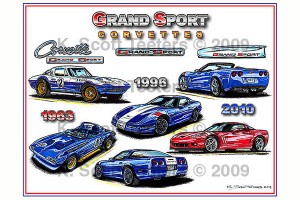
- Grand Sport Montage by K. Scott Teeters
___________________________________
Introduction by Vette magazine Writer and Artist K. Scott Teeters
For The Illustrated Corvette Series, the timing could not have been better. On April 24, 2009, Chevrolet dropped a bunker buster at the 12th annual C5/C6 Corvette Birthday Bash, held at the National Corvette Museum, in Bowling Green Kentucky. After 14 model years, The Grand Sport Corvette was back! The news went like wild fire across the internet. Those that knew what was in store, did an excellent job of keeping it mum, as I had not seen or read a single sentence about a pending new Grand Sport Corvette. Within a few weeks, the photos released from Chevrolet were on hundreds of Corvette websites and blogs. If you were a regular net surfer in search of the latest Corvette wave, you could NOT miss the Grand Sport. The red version with the white front fender hash marks screams, “Take me out on the highway and let me run! I can do 185-mph, really!”
I was about to roll into ICS No. 147 for Vette magazine, which was going to be a two-part story covering some of the most obscure Corvettes ever made – Zora Arkus-Duntov’s mule Corvettes. These were cars that were cobbled together for pure R&D purposes, never to be driven on public roads and destined for the crusher. They were noble, untamed beasts of burden, worthy of their stories being told. With the big round number “150” only two months out, I decided to cover the infamous ‘69 427 all-aluminum ZL-1 for No. 149, then do something really special for No. 150. What a perfect opportunity to not only cover the 2010 Grand Sport, but to put into historical perspective with the original five Grand Sport brothers and the first production Grand Sport in ‘96.
I made my pitch to VETTE Magazine editor, Jay Heath to do something special for my column’s 150th installment. I asked for two pages, color, and possibly the center spread if that was possible. Perhaps Zora was in Jay’s office when Jay read my email pitch. “Let da guy have a shot, Jay.” I imagined Zora whispering into Jay’s ear. Within a few hours, I got the green light from Heath, and now you get to look back and ahead. I hope that you enjoy, “Three Generations of Grand Sport Corvettes.” – KST PS – Yeah, I got the center spread. Color too!
The Story as it appeared in Vette magazine–
“Three Generations of Grand Sport Corvettes”
Illustrated and Written by K. Scott Teeters
Unveiling of the 2010 Grand Sport Corvette
There’s nothing quite like a surprise at a birthday party. On April 24, 2009, at the National Corvette Museum’s C5/C6 Registry Birthday Bash, GM officials floored the audience with the unveiling of the 2010 Grand Sport Corvette. The last time we saw a Grand Sport was more than 13 years ago, in 1996. Times were very different then, as the C4 was making its last appearance. Spy photos of the C5 were all over the car magazines, so Chevrolet’s challenge was maintaining customer interest in a car that was in its final year of production. The solution came in two parts: the Collector Edition—a special paint-and-trim option—and the stunning Grand Sport model. The Admiral Blue Grand Sport—with its white center stripes, red hash marks, black wheels, and other assorted details—was an instant classic.
1996 Grand Sport Corvette
Production was limited to just 1,000 units, and the $3,250 price made it the most expensive option for the ‘96 Corvette. But after six years of the $31,000-plus ZR-1 package, the Grand Sport seemed like a bargain. Since then, the C4 Grand Sport “look” has been applied to all sorts of Corvettes, with many delightful results.
But the Grand Sport story goes back much further than 1996. In fact, it stretches back 34 years, to late 1962 and a test session at Riverside Raceway. It was there that a disheartened Zora Arkus-Duntov saw his latest effort come up short against a formidable new challenge: the Shelby Cobra.
The Racing Grand Sports
Duntov and his team were “field testing” a new ’63 Sting Ray equipped with their latest racer kit, the Z06 option. Since 1957 Duntov had made sure that Corvette racers had an excellent foundation for competition. The 283 fuelie engine provided plenty of grunt, while RPO 684 provided suspension and braking improvements. The package was very successful and was the foundation for Corvette dominance in several SCCA racing classes. Duntov was very happy with the performance of the Z06-equipped ’63, thanks to a new frame that allowed the engine and driveline to sit lower, improving the car’s center of gravity. The four-wheel independent suspension was far superior to the earlier layout, which was described by many racers as, “stab ‘n’ steer.”
While most drivers were able to adjust their driving style to fit the Corvette’s unique handling characteristics, it was still a crude way of getting around the track. Many a track official had his wits scared out of him by a Corvette coming around a curve sideways, seemingly out of control. But the presence of the Cobra stopped the new Corvette in its tracks. Duntov and his crew had expected to be several steps ahead of the competition with their new car. Instead, they found themselves seriously outclassed. But Duntov always had “another” plan.
What happened then could never have taken place in the modern era. Fortunately, Duntov had very powerful friends at the top of GM’s food chain—namely, Ed Cole and Semon “Bunkie” Knudsen. It was Cole who hired Duntov in 1953 with instructions to do something with the fledgling Corvette. And although Knudsen was the son of William “Big Bill” Knudsen, the man responsible for GM’s quick turnaround during the war effort in 1940, he was no privileged rich kid. Knudsen learned the car business from the bottom up, working on the assembly line during his summer breaks from college. He also liked fast cars and was solidly behind Duntov’s racing efforts, so he understood the Corvette chief engineer’s dilemma with the new Sting Ray and the quicker Cobra. The obvious solution to level the playing field was to build a lightweight Corvette.
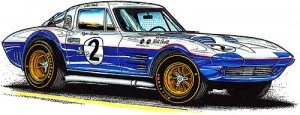
- Roger Penske’s 1963 Grand Sport Coupe #005
_________________________________________
Knudsen agreed and approved Duntov’s ambitious plans for the Grand Sport model. While the move might not seem like a big deal today, in 1962 GM was on board with the infamous AMA ban on factory-supported racing. The Grand Sport proposal was in direct violation of the ban and ran counter to GM’s official position. Duntov knew it, and Cole and Knudsen looked the other way.
Knudsen approved the construction of six lightweight Corvettes of Duntov’s design. After the six initial cars, 125 more Grand Sports were to be built to qualify for FIA homologation. Another 1,000 units would be produced for public consumption.
Duntov started with what was then a state-of-the-art ladder-type frame made from large-diameter steel tubing. The front suspension was similar to, but much lighter than, the stock Corvette setup. The rear suspension used the new Sting Ray independent design, but with an aluminum differential and drilled-out trailing arms. Girling disc brakes were used with Halibrand lightweight magnesium wheels and contemporary racing tires. The body was very close to the production Sting Ray, but used much thinner fiberglass. The final weight of the new Grand Sport was around 2,000 pounds.
Duntov had several exotic small-block engines in development, including one with hemi-style heads, another with double overhead cams, and even an all-aluminum fuelie. But none of Duntov’s exotic engines were anywhere close to being ready for competition, so a slightly modified 360hp fuelie was installed for initial shakedown runs. The first versions of the car looked almost stock, but by the time the Grand Sports arrived for the Nassau Speed Week races, they had a full complement of flares, scoops, and fat tires. The cars looked tough and pounded the Cobras. Then GM’s top brass found out and killed the program—officially, anyway.
It’s amazing that Duntov wasn’t fired on the spot, but as I mentioned earlier, he had friends in high places at GM. Even more amazing was that the cars were not sent to the crusher. Grand Sports 003, 004, and 005 boasted 377ci aluminum small-blocks that breathed through four 58mm Weber carbs each and made 485 hp. Cars 001 and 002, meanwhile, had been converted to roadsters. When GM discontinued the program, the cars began passing from racer to racer, as various privateers tried to make the Grand Sport into a serious competitor. But the mid-’60s were a time of tremendous advancement in race-car technology, and in just four years, the Grand Sports were seriously outdated.
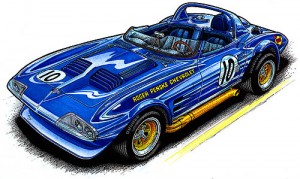
- Roger Penske’s 1963 Grand Sport Roadster #001
_________________________________________
All five original Grand Sport Racers are accounted for!
They had numerous problems that were never fully sorted out, including a terrible front-end lift that would occasionally pull the tires off the ground at high speed. Many famous drivers spent time behind the wheel of a Grand Sport, including A.J. Foyt, Augie Pabst, Jim Hall, Dick Thompson, and George Winterstein. In 1967 Alan Sevadjian bought one of the cars for just $7,500. By the 1970s the Grand Sports were all but forgotten and their whereabouts mostly unknown. The cars began to surface in the late-‘70s, and today all five are accounted for. In January 2009, at RM’s Automobiles of Arizona, Grand Sport 002, one of the two roadsters, was a no-sale at $4.9 million.
The 1996 revival of the Grand Sport Option
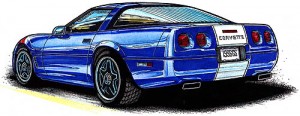
- 1996 Grand Sport Coupe
______________________________________
Fast-forward to 1996, and the revival of the Grand Sport option. Obviously the C4 edition couldn’t be a lightweight, tube-chassis racer. But it was an extremely well-executed collection of off-the-shelf parts. Under the hood was the new LT4 engine, an enhanced version of the base LT1 that made an additional 30 hp (up to 330 total) with basic hot-rod hardware. These included a higher (10.8:1) compression ratio, new aluminum heads with bigger ports and valves, a revised camshaft, Crane roller rocker arms, and higher-flow fuel injectors. The new engine redlined at 6,300 rpm and had an 8,000-rpm tach. All 1,000 Grand Sports were painted with Admiral Blue paint and had a wide white stripe that ran from the nose to the tail.
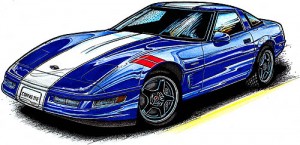
- 1996 Grand Sport Coupe Front View
_________________________________________
The ZR-1–style 17-inch wheels were painted black, and flares originally developed for the Japanese export market were installed on the rear fenders. As a salute to the Grand Sport racers, red hash marks were applied to the left front fender. The Z51 suspension option was available to stiffen up the car’s handling. Of the 1,000 cars built, 810 were coupes and 190 were convertibles. (The latter didn’t have the wider tires and the rear fender flares.) Priced at $3,250 for the coupe and $2,880 for the droptop, option Z16 became an instant classic. These days, show organizers like to put all the C4 Grand Sports together in rows, where they make for a dazzling presentation.
The C6 2010 Grand Sport is a different animal!
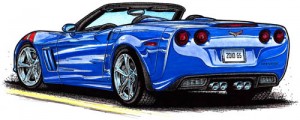
- 2010 Grand Sport Corvette Convertible
_____________________________________
The C6 Grand Sport is a completely different animal. The base LS3 engine produces 430 hp—100 more than the old LT4. The new option fits neatly between the base Corvette and the Z06 and is available on both coupe and convertible models, in all color combinations. Oddly enough, the signature fender hash marks are optional. Perhaps most notable are the Z06 body panels, which include front and rear flared fenders, a front air-splitter, and a rear spoiler. The rear brake-cooling scoops are functional, but the front nose scoop is not. Visually separating the Grand Sport from the Z06 are a set of revised front-fender vents, with their ’67-inspired vertical slats. Model-specific five-spoke wheels are available in silver, Competition Gray, or chrome. The fronts measure 9.5 x 18 inches and are shod with Goodyear F1 run-flat tires sized 275/35ZR18. The 12 x 19-inch rears, meanwhile, get massive 325/30ZR19s. The front brakes have been enhanced with cross-drilled 14-inch front rotors and six-piston calipers, while the rears boast 13.5-inch rotors with four-piston binders. All four calipers are painted silver and wear red “Corvette” lettering.
Since the Grand Sport replaces the Z51 Performance Option, all of the Z51 goodies—heavy-duty springs, shocks, and stabilizer bars, along with coolers for the engine oil, transmission fluid, and steering fluid—are included. Additionally, all six-speed manual cars come with the Z52 option, which adds a dry-sump oil system, a rear-mounted battery, and a differential cooler. Manual cars also receive a new launch-control system. This system allows the driver to simply floor the gas, at which point the computer automatically selects the optimum launch rpm. All that’s left for the driver to do is drop the clutch and start shifting. All of the standard Corvette options are available on the Grand Sport, including four trim packages and the Dual Mode Exhaust System. Priced at $55,720 for the coupe and $59,530 for the convertible, the new Grand Sport is still around $15,000 less than a Z06. Zero-to-60 times clock in at 4 seconds flat, with quarter-miles in the low 13s or better. The car generates 1.0g on the skidpad and has an EPA rating of 26 mpg on the highway. Top speed is between 185 and 190 mph, making the latest Grand Sport faster than even the old racing versions.
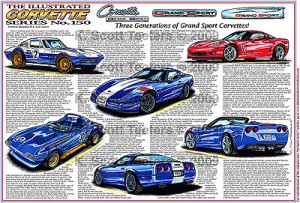
- The Illustrated Corvette Series #150 as it Appeared in the Dec 2009 Vette issue.
________________________________________
For at least the first 20 years of its existence, the Corvette was always a hair’s breadth away from being canceled. Thanks to dedicated engineers like Duntov, McClellan, Hill, Juechter, and many others, the C6 Grand Sport can take its place among the greats of Corvette history. – K. Scott Teeters
Grand Sport Links:
K. Scott Teeters GrandSportCorvetteLegend.com
Wikipedia on Grand Sport Corvette
Chevrolet’s 2010 Grand Sport Corvette Page
For the History of the Grand Sport as an “Epic Tale” Click Here.
2010 Grand Sport Reveal at National Corvette Museum
Video of new 2010 Grand Sport Corvette with GM’s Harlan Charles
Time for your two cents:
What do you think of the 2010 Grand Sport?
Do you have one of the older Grand Sports?
Do you think $58K is a bargain price for this performnance car? Why/Why not?
